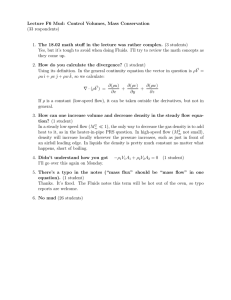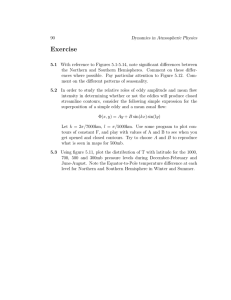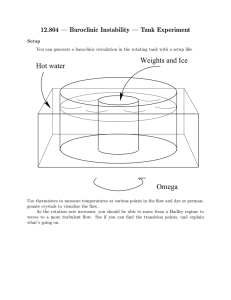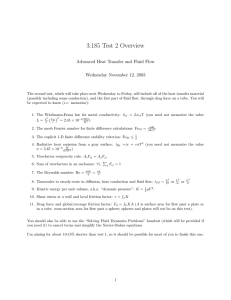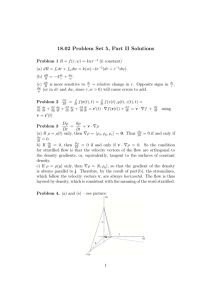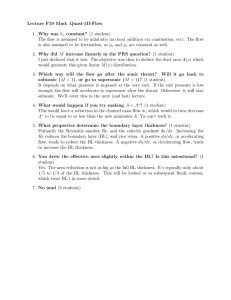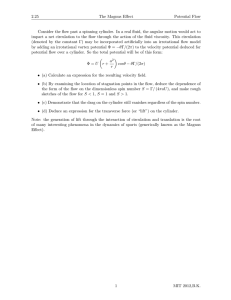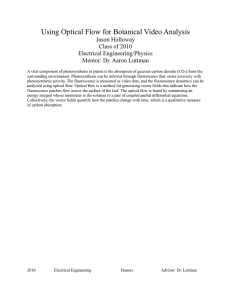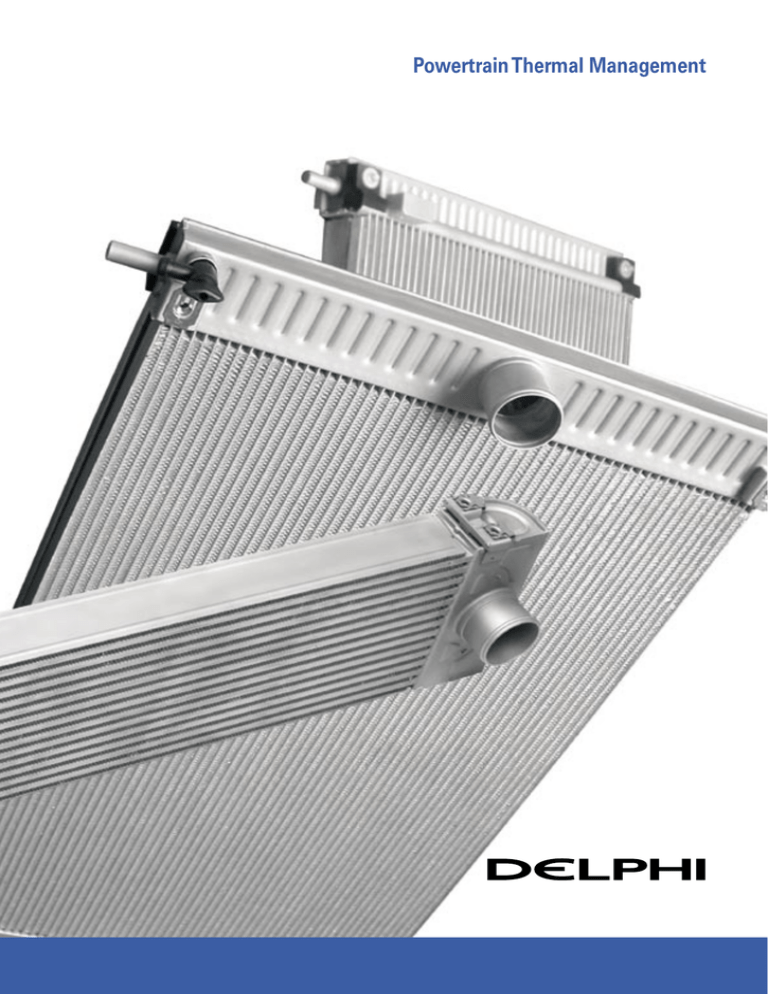
Powertrain Thermal Management
In the next example – figure 2 – it is seen that the heat exchanger has now acquired
secondary surface to enhance the heat transfer area and the location is now wrapped around the front of the vehicle where it can take some advantage of any relative
Introduction
movement between the air and the vehicle.
Right from the early days of the internal combustion engine it was recognised that measures had to be taken to avoid excessive metal
temperatures. For automotive application the
most common approach was to use liquid cooling although a number of successful air cooled solutions have appeared over the years,
Figure 2.
Radiator wrapped around front
of vehicle
most notably the original Volkswagen Beetle.
With today’s very high power densities this
is no longer a viable solution and virtually all
automotive engines are liquid cooled and the
basic principles of the cooling system have
changed very little over the intervening years.
The cooling fluid is pumped through passages
At a very early stage the radiator reached its traditional configuration with a heat
transfer matrix located between two header tanks and its traditional location at the
front of the vehicle, fully exposed to the effects of the ram air generated by the
vehicle forward motion – figure 3.
in the engine block and is subsequently passed
through a heat exchanger in which the heat
from the engine is transferred to the atmosphere. An early example of an engine cooling
heat exchanger is shown in figure 1.
Figure 3.
Traditional radiator configuration
and location
All this is not to suggest that there has been little development in the intervening
period. The understanding of the heat transfer processes within the engine has
greatly advanced allowing engine cylinder head designs that can accommodate
Figure 1.
Radiator at rear of early vehicle
higher heat fluxes by more than an order of magnitude compared with those from
the early days. System components have been subject to intensive development
and, for example, the heat exchangers of today have become an order of magni-
It consists of an array of bare tubes and since
tude more compact than those of 50 years ago. Whilst the basic system layout has
it is located at the rear of the vehicle it relies
changed little over this period, in recent years there has been an increasing imple-
almost totally on natural convection on the air
mentation of electronic control to improve the management of transients, engine
side.
emissions and energy consumption.
The essential components of the basic system are shown in figure 4. The coolant is driven round the system by a centrifugal pump which is traditionally belt
driven from the engine. The coolant passes through the engine where it picks up
the rejected heat and is passed to a heat exchanger – the radiator – where the
heat is in turn transferred to the cooling air which passes over the outside of the
engine block
thermostat
pressure
cap
radiator surface. The flow of cooling air through the radiator matrix is generated by a combination of fan and ram air that comes from the movement of the
expansion
bottle
vehicle over the ground. The fan can be either engine or electric motor driven.
radiator
When the engine starts from cold the thermostat outlet to the radiator is closed
coolant
pump
and the coolant flow generated by the pump passes only through the cylinder
fan
head and engine block. The engine and coolant gradually warm up until the stage is reached at which the wax thermostat responds to the increasing coolant
Figure 4. Basic layout of engine cooling system
temperature and the outlet to the radiator opens. The process of radiator heat
rejection to the atmosphere is initiated and at this stage the thermostat takes
over control of the system – as the temperature of the coolant at outlet from the
engine reaches its control point, so the thermostat opens to increase flow to the
radiator and inversely, as the temperature drops below the control point, the
thermostat closes down to reduce the coolant flow to the radiator.
Engine Coolant
In the early days of the automobile water was the standard cooling fluid because of its very attractive thermo-physical properties as well
as its wide availability and low cost. However water has two basic weaknesses. The first is the relatively high freezing point of 0°C which
resulted in the risk of ice formation within the system in cold ambients. The freezing of water is accompanied by a significant increase in
its specific volume and the accompanying expansion frequently resulted in the destruction of engine block and/or radiator. The second
weakness is the relatively low boiling point of the fluid. The solution to the first problem was to mix a percentage of ethylene glycol
with the water which has the effect of reducing the freezing point – the more ethylene glycol, the greater is the reduction. A commonly
used strength for the European market is a 50/50% mixture by volume which reduces the freezing point to -37°C. As well as this freezing
temperature reduction the resultant mixture has another advantage in that, on solidifying, it does not become a hard and rigid solid as
does pure water but goes through a ‘mushy’ stage that also helps to avoid physical damage to the system should extremely low temperatures be experienced.
The relatively low boiling temperature of pure water carries the risk that should coolant temperatures become high enough, boiling
occurs with the resultant loss of coolant as pressure relief systems operate. In the early days this problem was compounded by the
unreliability of pump shaft seals which could also result in significant coolant loss. The Swiss solution to these problems was to locate
water taps and pouring vessels at the top of each of the Alpine mountain passes! The use of ethylene glycol in the coolant is part of the
more modern solution to this problem as the boiling point of the 50/50 mixture is increased to 108°C at atmospheric pressure. This also
has the advantage that it increases the available temperature difference for heat transfer in the radiator.
Even the raised boiling temperature of the 50/50 EG mixture is insufficient for modern systems and in order to meet today’s cooling requirement the system operating pressure has to be raised in order to increase even further the coolant boiling
point and the available temperature difference for heat transfer. This is achieved by
building a pressure relief mechanism into the radiator cap. As the coolant climbs in
temperature during the warm up process it also expands as a result of which the
pressure in the system increases. This continues until the pressure is sufficiently
great to lift the valve in the radiator cap and the excess coolant is free to flow into
the expansion bottle. As the system cools down, its pressure eventually becomes
low enough for a second relief valve in the radiator cap to open to allow the coolant
to be sucked back into the system from the bottom of the expansion bottle. The use
of a 1 bar pressure cap raises the boiling temperature of 50/50 coolant to 128°C.
Figure 5. Heater core for comfort heating
Engine Thermal
Management
Two variants are common - an oil-to-coolant heat exchanger located in the outlet
tank of the radiator or a direct oil-to-air heat exchanger located in a number of
different possible locations in the vehicle.
There is more to powertrain thermal management than engine cooling alone. The need for
heating in the passenger compartment soon
led to the implementation of small heat exchangers – figure 5 – to tap off some of the heat
from the coolant and supply it to the cabin.
Figure 7. In-tank transmission oil cooler
More recently, with the implementation of
turbo-charging, the use of charge air coolers
Whilst the vehicle air conditioning system is not part of the engine thermal
has become widespread. The task of the charge
management system as such, its implications have to be taken into account since
air cooler – figure 6 – is to reduce the tempe-
it is common to mount the larger heat exchangers, radiator, charge air cooler and
rature of the compressed charge air to increase
a/c condenser in a module at the front of the vehicle. Since the condenser has the
its density and thus to increase the mass of air
lowest outlet temperature requirement it is usual to mount it so that it has first
delivered to the combustion chamber.
exposure to the cooling air with the result that the radiator, mounted down stream
of the condenser, has to provide its cooling duty with air that is already preheated.
This has obvious implications for the radiator performance requirements and hence
the final design.
System Components
The most important keys to a successful engine cooling system are the heat exchangers and the two generators of fluid flow – the coolant pump and the fan.
Radiator
Two basic heat exchanger core configurations are used in automotive radiators,
both in aluminium – the mechanically expanded round tube and plate fin surface
Figure 6. Full face air-to-air charge air cooler
and the brazed core with flat sided tubes and corrugated louvred fin.
A further thermal management requirement
arose with the introduction of automatic transmission systems. These are somewhat less
efficient than the traditional gear box and the
transmission oil temperature often needs to be
managed with the use of an oil cooler.
Tube-and-Fin
Tube-and-Centre
Figure 8. Radiator Core types
The tube-and-fin surfaces – figure 8 – are restricted to the lower cooling duties as
the surfaces cannot compete with the high specific performance and low air side
pressure drop characteristics of the tube and centre configuration. This remains
true even with advanced versions of the former using oval tubes and louvred fin.
The advantages of the tube-and-centre configuration come from the flattened tube
which contributes to the low air side pressure drop and the louvres in the fin that
greatly enhance heat transfer coefficients. The enhancement comes from the fact
that the inclined louvres serve to realign the air flow with their plane and as such
provide multiple leading edges which result in thin boundary layers and high heat
transfer.
It is possible to cut louvres into the tube-and-fin surfaces but they are less effective
because they cannot be cut close to the tube wall for fear of weakening the mechanical joint between fin and tube and enhancement is proportional to the cut length
Figure 9.
Flow re-alignment through a louvre array - scale
model in water channel
of louvre.
Whilst the tube-and-fin surfaces cannot compete with the tube-and-centre versions
on pure performance, the reasons they are sometimes used for the lesser cooling
duties is a question of cost. With no need for the use of brazing sheet nor the brazing process itself, under some conditions they can be cheaper to produce.
Since louvres yield such a high degree of enhancement, the detail of their design
and manufacture proves to be a key factor in the determination of performance.
As the number of possible dimensional variables of the fin is very large the establishment of the optimum configuration for a given application is not a simple
task. Nowadays CFD tools are sufficiently powerful to give accurate predictions
of surface performance despite the very complex small scale and 3-dimensional
nature of the flow through the louvres and fins – figure 10.
Figure 10.
Air stream-lines and velocity through louvred fin
The 2-d image of laminar flow that becomes parallel to the louvres shown in Figure
10 is not the whole picture. At low velocities the boundary layers on the louvres become sufficiently thick to effectively block off the gap between louvres with the result that the air switches back to flowing between the fins and thus straight through
the radiator without being deflected by the louvres. At the high velocity end of the
operating range the simple laminar flow can begin to be disturbed by the shedding
of vortices from some of the louvres – figure 11. This enhances heat transfer further
but at an increasing flow resistance penalty.
Figure 11. CFD analysis showing initiation of flow
instability from louvres at high velocity
The flat-sided tubes have traditionally been
The net result of all this performance optimisation is that the modern radiators can
formed from strip and seam welded in one
meet many applications with a core thickness of only 12mm where 25 or 30mm
process but more recently folded tubes
would have been needed some thirty years ago.
– figure 12 – have become available with which
the tube joints are only made in the final core
The radiator tanks for both types of radiator – picture 13 – are usually of injection
brazing process. The tie bar formed across the
moulded construction with a crimped gasketed joint between header plate and
centre of the tube serves as a structural mem-
tank.
ber and allows thinner material to be used.
Although the thermal resistance of the tube
side of the heat exchanger is a relatively small
fraction of the whole it can still sometimes be
worth enhancing the heat transfer on the tube
side. In this case a pattern of depressions are
formed into the walls of the tube during the
forming process.
Folded tube
Figure 13. Radiator tank clinched on header
s
Folded tubes
with dimples
It is perfectly feasible to use pressed aluminium tanks and to braze the complete
heat exchanger assembly in one shot which would seem to offer a financially attractive alternative to the injection the moulded tanks. However, it is found that
very many features are usually integrated onto the injection moulded tank for the
addition of relatively small extra tooling cost – items such as mounts for radiator
and fan, sensor bosses and drain tap, etc. The equivalent all-aluminium solution
requires a number of extra parts and processes to meet the same requirements
Figure 12. Folded tubes
which make it an uncompetitive solution.
Charge Air Cooler (C.A.C.)
A turbocharger uses energy remaining in the exhaust to drive a turbine which in
turn drives a compressor that compresses the engine intake air to raise its density, thus allowing increased fuelling and hence increased power output. Since the
compression process raises the air temperature as well as the air pressure, this
means that a portion of the increase in air density has been lost. This can be recovered by rejecting some of this heat to the atmosphere in a charge air cooler.
Charge air cooling systems come in two basic types – air cooled or water cooled.
The former rejects the heat directly to the atmosphere in an air-to-air heat exchanger whilst in the latter the heat is first rejected to liquid coolant in the air-to-water
heat exchanger contained in a dedicated coolant loop.
This loop also contains an air to coolant heat exchanger in which the rejected heat
is then passed to the atmosphere. The water cooled charge air cooler tends to be
confined to high power engines when it becomes difficult to package a sufficiently
large air-to-air heat exchanger. Whilst the cooling requirements for air-to-air and
air-to-coolant are similar the latter heat exchanger can be much more compact
as a result of the much lower thermal resistance of the coolant compared to air.
The water cooled charge air cooler is usually located close to the engine air intake
which has advantages for the response time of the system and the reduction in
so-called ‘turbo lag’. However it carries a potential performance penalty as the heat
has to be transferred across two temperature steps rather than just one.
Most charge air cooling systems in the European market use direct air-to-air heat
exchangers. These come in three variants, depending upon their basic shape and
the location of the heat exchanger in the vehicle.
The ‘box’ type of charge air cooler is used at the lower end of the cooling duty
range. It occupies the smallest volume of the three types and is usually located in
a wheel arch or in the engine compartment.
The second air-to-air charge air cooler configuration is known as a bed type – figure
14. It is located below the radiator and condenser in the front-end heat exchanger
module so that it is exposed to the air flow generation both from the cooling fan
and the ram effect.
Figure 14. Bed type air-to-air charge air cooler
A typical example of the third type of charge
However, the tube dimensions are correspondingly large in order to meet the low
air cooler, known as ‘full-face’ – figure 15 –
pressure drop requirement – typically 30 to 50mm major axis x 8 to 10mm minor
occupies the full frontal area of the heat
axis. The tubes contain secondary surface in the form of internal fin that can be
exchanger assembly and is located between
plain or offset strip depending on the exact performance and pressure drop de-
radiator and condenser.
mands of the application.
As an example of the structural analysis that is necessary to ensure adequate
strength at the same time as minimizing weight the results of finite element analysis to establish the necessary thicknesses for the tube wall and the inserted
secondary surface is shown in figure 17. It is clear that the inserted fin acts as a
structural member and the analysis identifies the stress concentration at the tube
nose that occurs as a result of internal pressure.
Figure 15. Full face air-to-air charge air cooler
This means that a high volume cooling air flow
is required under all conditions to avoid compromising the charge air cooler performance
as a result of the temperature pick-up from the
air conditioning condenser.
A key performance characteristic of all the
charge air coolers is the pressure drop on the
charge air side. Since the whole purpose of
charge cooling is to regain some of the den-
Figure 17. Finite element analysis of charge air cooler tube
sity lost due to temperature increase, to lose
it again due to charge air cooler pressure drop
serves no purpose. For this reason the air
cooled heat exchangers have the same basic
core configuration as radiators with corrugated
fin and flat sided tubes – figure 16.
The pressure drop on the cooling air side is also an important performance parameter for the charge air cooler. Since sufficient cooling air flow is important
for the heat exchangers upstream and downstream of the charge air cooler, its
air flow resistance must be kept to a minimum. For this reason plain, unlouvred
fin is sometimes used or else low density fin with a relatively ‘mild’ louvre configuration.
Header tanks for charge air coolers can be either aluminium or injection moulded
glass filled plastic. In this case the tanks do not need to carry extra features and
so the choice will depend upon the trade off between tooling and part costs.
There is a strong trend towards increasing turbo-charger pressure ratios with the
implication that charge air temperatures are increasing also. The highest temperatures can no longer be accommodated by the engineering plastics and alumiFigure 16. Air cooled charge air cooler tubes
nium tanks are necessary in this case.
Fans
A fan is required to generate the necessary air flow with the vehicle stationary and
to supplement the ram air generated flow with the vehicle moving. In the early
days of the automobile the fans were driven by the engine. This option still exists
with the highest powered engines but in most cases the duty is taken over by
electrically driven fans. The disadvantage of the engine driven fan is the fact that
it has to be capable of delivering the required air flow at low engine and vehicle
speeds which means that it is over designed for higher engine speed with resultant
absorption of more power than necessary.
The reason for the use of an engine driven fan is that for high powered vehicles the
demand for cooling air can be so great that insufficient electrical power is available
to meet the need electrically. In some cases viscous fan drives are used with engine driven fans in order to reduce the power consumed at higher engine speeds.
Electrical fans can be located before or behind the front end heat exchanger module – figure 18. One, two or even three fans distributed between front and back
can be used. The fans can be shrouded or open. The shroud is used to reduce the
risk of air recirculation from downstream back into the front of the heat exchanger.
The open fan configuration makes better use of the ram generated air flow.
Figure 18. Electrically driven fans
A high level of expertise combined with extensive practical experience goes into the development of a new fan design. To ensure optimum performance the design must be specific
to the eventual system and its operating environment. The first design step uses 1-d design
tools to establish the important fan load points
based on a systems level analysis. Axi-symmetric 2-d tools are then used to determine
the flow profile at inlet to the fan. The process
continues with the development of the NACA
(National Advisory Committee for Aeronautics
– figure 19) based blade profiles, a process that
again requires significant experience in the
manipulation of the input. A final CFD (Computational Fluid Dynamic – figure 20) based
fine-tuning process considers flow uniformity,
blade loading and the elimination of flow separation at blade leading and trailing edges.
Systems Issues
Figure 19. NACA Series blade profiles
A number of issues arise in powertrain thermal management which can only be
considered at the systems level.
System Control
As engine cooling is required the coolant flow rate through the radiator is automatically controlled by the thermostat. The power to the electrically driven fans is also
controlled – usually by means of electrical resistance switched into or out of the
circuit – so that the highest air flow rates can be delivered when required. Variable
control fans with PWM motors are used in some cases with resultant improvement
in efficiency but at significant incremental cost. The fans are also controlled by the
Figure 20. CFD analysis at trailing edge
mid blade
demands of the air conditioning system – as head pressure at the condenser approaches the limiting value more air flow is called for.
Cooling air flow rate
The flow rate of cooling air through the heat exchangers is obviously a key parameter defining the performance of the system. It comes from two sources – the
fans and the ram effect generated by the movement of the vehicle through the
atmosphere. As far as the ram air is concerned there is a trade-off between a desired high flow rate for good heat exchanger performance and a low flow rate for
minimisation of overall vehicle drag. The flow of air through the front end of the
vehicle adds a typical 5% to the vehicle drag.
There are three basic approaches to the establishment of front end air flow rate
under particular operating conditions. At the most sophisticated level complete
CFD analyses – figure 21 – can be performed which model the detail of the air flow
around the outside of the complete vehicle and through the vehicle front end and
engine compartment including the various heat exchangers and even through the
rotating fans. This method delivers a great deal of information about the system
but is demanding in terms of computing effort.
Figure 21. CFD analysis of flow through vehicle front end and heat exchangers
At the intermediate level of complexity commercial software exists that allows
networks of 1-d components to be set up and the air flow distribution through
them to be calculated – figure 22. This can be valuable when problems arise such as
air recirculation or significant temperature and/or flow rate mal-distribution.
Figure 22. Typical cooling system network for airflow rate analysis
Despite the sophistication of these develop-
The appropriate values for the unknown system and fan constants (F, ψo, ζSys, ζF)
ment tools there exists a much simpler tool for
are determined from wind tunnel measurements of air flow rates through the heat
the prediction of front end air flow that proves
exchangers for ranges of different vehicle speeds and fan speeds – figure 23.
to be capable of delivering considerable insight into the way the system is behaving.
The pressure drop coefficients of the heat exchangers as functions of air flow rate
It is based in a 1-d model that characterizes the
are already known. The values of the system constants are extracted from the ex-
face air flow velocity through the heat exchan-
perimental dataset using non-linear optimisation techniques. Knowledge of the
gers,
values of these parameters for a system allows the air flow rate through the heat
νR, in terms of a few non-dimensional
constants:
exchangers to be explored for any vehicle speed or fan speed and even allows the
effects of different heat exchangers to be evaluated.
F is a measure of the effectiveness of the front
end shape in delivering
νο is vehicle velocity
ψo is the maximum non-dimensional pressure
coefficient of the fan
ua is fan tip speed
ζR is pressure drop coefficient of the heat exchangers
ζSys is pressure drop coefficient of the remainder of the system (grill, engine compartment
etc)
ζF is a pressure drop coefficient for the fan
itself
Figure 23. Anemometers mounted on heat exchangers
for wind tunnel air flow measurement
Environmental implications
It has already been indicated that the need for an air flow through the front of the
vehicle has implications for vehicle drag and hence for fuel consumption. For this
reason the target is to keep air flow rate to the minimum required to meet the
cooling requirements. For the same reason different models of the same platform
with different cooling requirements can have different openings at the front end
– this in order to influence the value of F and thus achieve the necessary air flow
rate at minimum vehicle drag.
The second significant implication of the engine cooling system is the power consumed by the pump. Since the pump is traditionally driven directly from the engine there is very little ability to line up the energy going into the pump with the
real cooling need. In recent years systems have begun to appear that use variable
speed electrically driven pumps that give much greater control over pump power
consumption. At the same time thermostats are being replaced by electronically
controlled valves that again add to the ability to control power consumption and
offer further environmentally beneficial features. It now becomes possible to cut
the coolant flow rate through the engine to really low levels during the warm-up
process. This allows it to come up to operating temperature very rapidly and demonstrates useful reductions in both exhaust emissions and fuel consumption.
As it can be imagined, this technology is quite expensive and an interesting new
proposal concerns a novel coolant pump with adjustable inlet vanes which can be
used to control the capacity of the pump by adjusting the pre-swirl at the pump
inlet.
positive
zero
negative
Figure 24. Guide vane positions for pre-swirl at inlet to variable flow pump
The vanes can by controlled with a simple wax-filled actuator or can be electrically
driven and electronically controlled. The vanes can also fully close off the pump
inlet and thus effectively act as a thermostat – figure 24. Again, useful gains in
efficiency have been demonstrated with this system.
Future Powertrains
As it becomes clearer to the world at large that
climate change is a reality that needs some response on our part, so it becomes apparent that
future automotive powertrain needs are unlikely to be met by the simple internal combustion engine. Hybrid electric/ic engine systems
are beginning to appear on the market and
fuel cell vehicles are promised to be around
the corner. The implications for thermal management systems for both are significant.
Figure 25. Cooling module for PEM fuel fell vehicle
There is a wide range of possible hybrid vehi-
The PEM fuel cell vehicle – figure 25 – represents a much more demanding thermal
cle configurations and the important implica-
management application despite its high thermal efficiency. The reasons are that
tions for thermal management system design
all the heat is rejected through the coolant compared with the IC engine in which a
depend upon the power split between electric
large portion of the waste heat passes out in the exhaust gases. A second reason is
and IC engine drive. Since the electric traction
that the fuel cell stack has to be kept down to a temperature of 80°C which means
motor rejects significantly less heat than an
that the available temperature difference for heat transfer is also greatly reduced.
equivalent power IC engine then the higher
The net result is that cooling air flow rates need to be some 60% higher than the
the fraction of electric power the lower will be
equivalent IC engine and the frontal areas of the cooling radiators need to be si-
the requirement for cooling air flow.
gnificantly larger. Figure 20 shows a typical cooling module with the electronics
cooler and air conditioning condenser at the front and behind them a main stack
The cooling requirement for the electric drive
cooler of more than one and a half times the frontal area of that for the ic engi-
per unit power is approximately half that of the
ned vehicle. Even this frontal area is insufficient and supplementary radiators are
IC engine. However the hybrid vehicle systems
shown mounted one in each wheel arch.
will have a significant increase in complexity
needing separate cooling systems for IC
engine, traction motor/generator and inverter
drive, battery pack and transmission system.
Conclusion
As we have seen, the thermal management system of a vehicle can make a measurable contribution to the reduction of the
environmentally damaging effects of the whole vehicle. The management of front-end air flow can minimize the effects on vehicle drag
coefficient. The detailed design of the heat transfer surfaces can minimize their weight and their internal volume and hence weight of
coolant. The ability to design efficient fan profiles allows the minimization of fan power. The use of electrically driven coolant pumps
and together with electronic system control enables the minimization of coolant pumping power and active management of the engine
warm-up process with the potential for significant reductions in engine emissions.
This paper has shown with a few selected examples how a detailed understanding of the technology of the major components and the
complete system can result in a system that makes a significant contribution to the saving the environment
World Headquarters and Customer Center
5725 Delphi Drive
Troy, Michighan 48098-2815
USA
Tel: [1] 248.813.2000
Fax: [1] 248.813.2670
Global Powertrain Systems Business Unit Headquarters
Global Electrical & Electronic Architecture Business Unit Headquarters
European Thermal Business Unit Headquarters
Customer Technology Center
Avenue de Luxembourg
L - 4940 Bascharage
G.-D. Luxembourg
Tel: [352] 50.18.1
Fax: [352] 50.18. 22.88
delphi.com
Printed on Recycled Paper
©2007 Delphi Corporation.
All rights reserved. DCTC Lux 0107-F
About Delphi. Multi-national Delphi conducts its business operations through various subsidiaries and has headquarters in Troy, Michigan, USA, Paris, Tokyo and São Paulo, Brazil.

